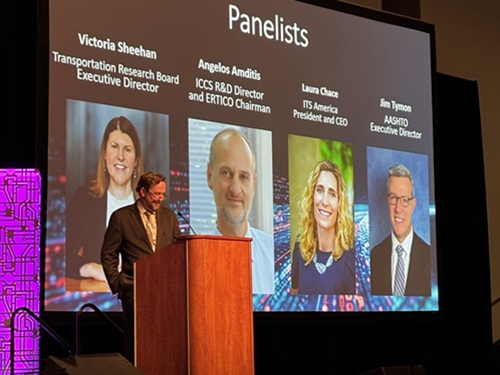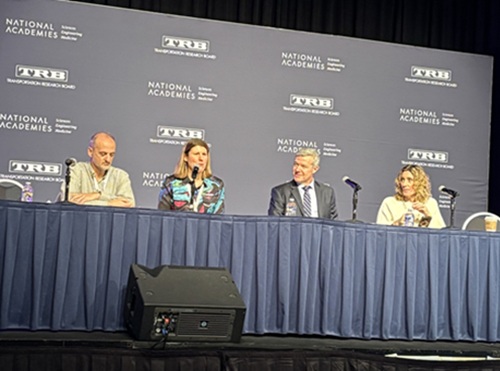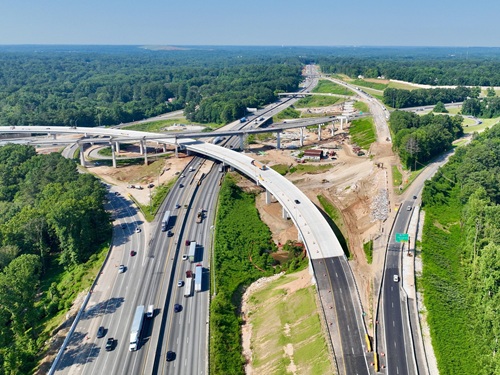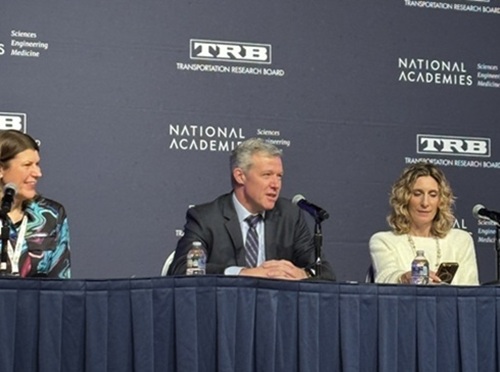A panel session at the 2025 Transportation Research Board Annual Meeting in Washington, D.C., detailed how technology is poised to play a pivotal role in the transportation sector’s future.
[Above photo by AASHTO]
Moderated by Alasdair Cain, director of research, development, and technology for the U.S. Department of Transportation, the panel featured Jim Tymon, executive director of the American Association of State Highway and Transportation Officials; Victoria Sheehan, TRB’s executive director; Laura Chace, president and CEO of the Intelligent Transportation Society of America; and Dr. Angelos Amditis, research director of the Institute of Communication and Computer Systems or ICCS, who serves as chair of ERTICO – ITS Europe, a public-private and cross-border intelligent transportation initiative.

The panel discussed how technological tools in the digital age can significantly enhance the future of transportation and improve operational efficiency, while also helping transportation agencies add new capabilities.
“State departments of transportation are not the same agencies they were 50 years ago when they were building out our transportation system,” said AASHTO’s Tymon. “There is a new emphasis on how we better operate on the systems we currently have. We need to look at how to better use technology and data. [That’s why] I do think technology will play a role that it has never played before as we take that next big step; whatever that next big step is.”
Tymon said one of those “next big steps” in this ongoing effort is the “Moonshot” or “Visioning Project,” where state DOTs are looking to find the next logical step to change transportation for the better.
Established in 2021 and approved to move forward by AASHTO in October 2022, this “Visioning Project” is an effort to draft a “cohesive national transportation vision” for the United States and is referred to by that name as it seeks to harness similar “aspirational energies” like the ones behind the effort to put a man on the moon in the late 1960s.
Tymon noted that this endeavor seeks to shift the transportation sector’s focus from daily operations to identifying areas where it can achieve large-scale improvements, whether in safety, operations, technology, energy, or other key areas.

“The project is designed to create future vision for our transportation network,” he explained. “We are not looking at smaller changes but rather big leaps to bring out the transportation system of the future.”
Sheehan discussed how TRB has teamed up closely with AASHTO and state DOTs through the “Moonshot Project” as well as other research ventures as part of this transportation evolution effort.
“The Moonshot Project has taught us a lot,” she noted. “With the moonshot, there have been states that stepped up to the plate and took the lead on those projects. There are other states that shadow others and work on their own deployments.”
Sheehan added that, as new technologies continue to emerge, transportation leaders will need to underscore their importance so they can train staff and build a skilled workforce to effectively use them to improve system performance across multiple metrics.
“We want to do better,” she stressed. “We have to do better, especially when it comes to safety, accessibility and resilience.”
ITS America’s Chace emphasized how building out a national “framework” can make a huge difference on how both the public and private sector implement technological advancements within the transportation sector.
“We can create a national vision and roadmap … and use our digital tools to enable it,” she said.
Emphasizing change management as a big factor of moving technology forward, Chace stressed, saying that if technology is not incorporated into the thinking, technology will not be successful. “For public agencies, incorporating these new technologies is a challenge and change management is a challenge,” she said.
One of those challenges, noted ICCS’s Amditis, is the “need to cover the gaps” between technology and deployment.
“Innovation is a low hanging fruit,” he stressed. “We need to address the digital divide issue that we have today.”
To that end, as technology development progresses, AASHTO’s Tymon stressed the importance of educating all parties involved to get everyone behind a clear and comprehensive national strategy.
“Two of the biggest challenges are on the education side and the workforce side,” he explained. “Data is a huge opportunity and a challenge for us; a lot of transportation agencies are struggling with what to do with the data we have. I think there is a great opportunity to better use the data we have at our disposal, but we also need to educate people on how to best use that information.”
That is why collaboration will be crucial for advancing the future of transportation and taking the next big technological leap, Tymon noted – adding that AASHTO is partnering with the U.S. Department of Transportation to set up a series of peer exchanges in 2025 with state DOT leaders to discuss how technology and innovation can improve the nation’s transportation networks.
“The hope is to bring together the small group of state DOT CEOs and see how they have been successful in utilizing technology in their agencies, as well as where they have been unsuccessful,” said Tymon. “We can learn just as much from our failures as we can from our successes – especially when it comes to technology.”
 Top Stories
Top Stories
How Rising Construction Costs Could Impact Reauthorization
November 14, 2025 Top Stories
Top Stories

